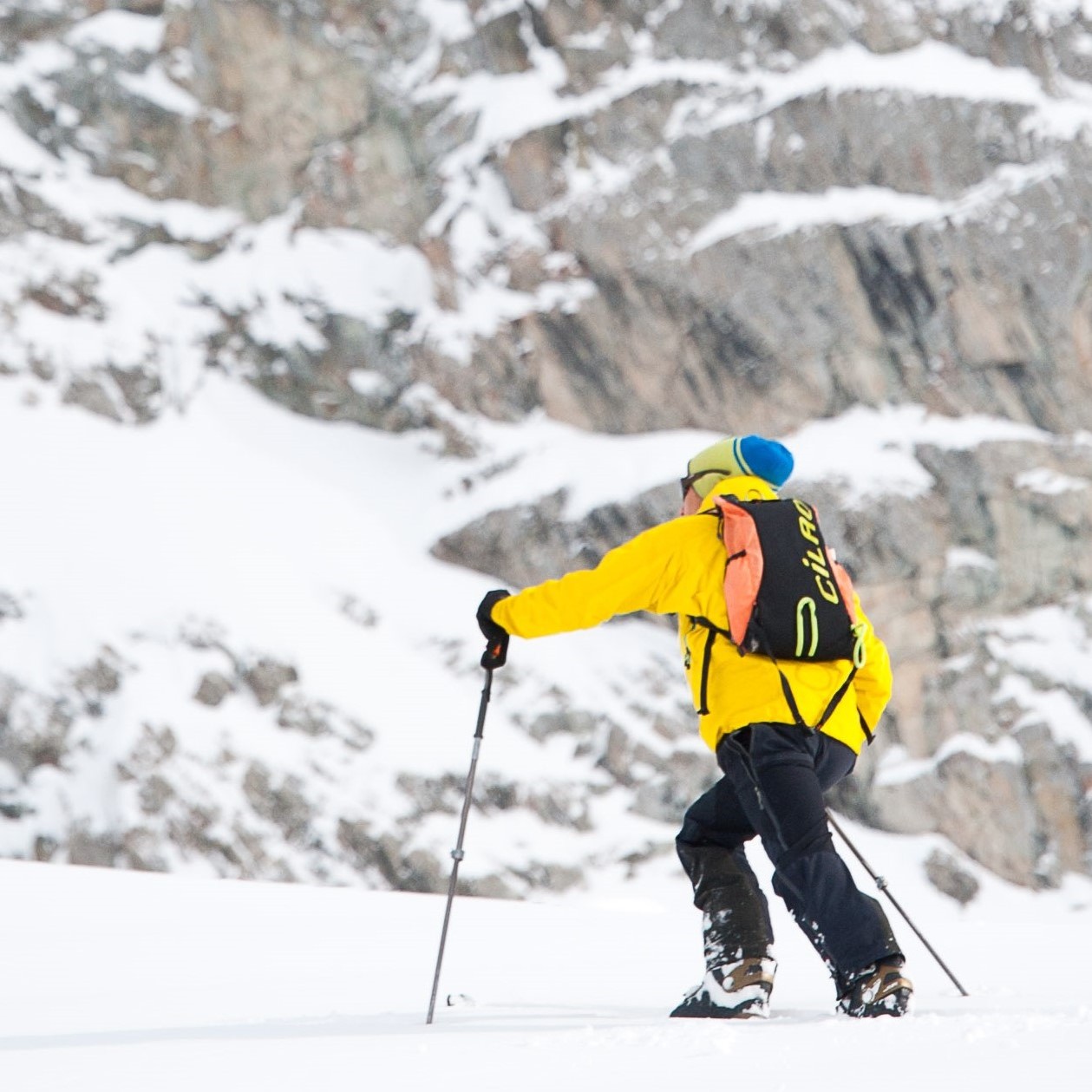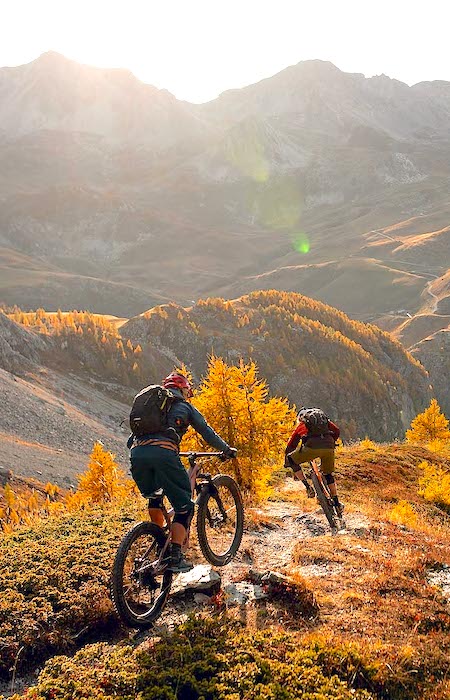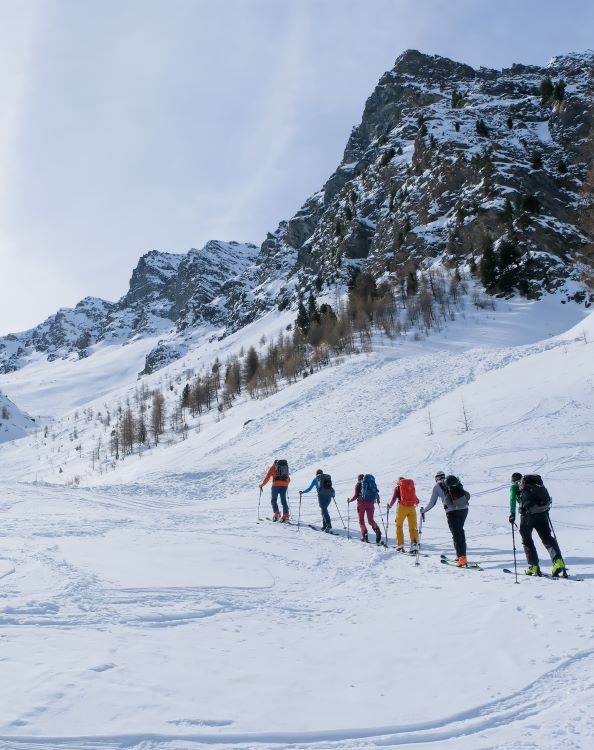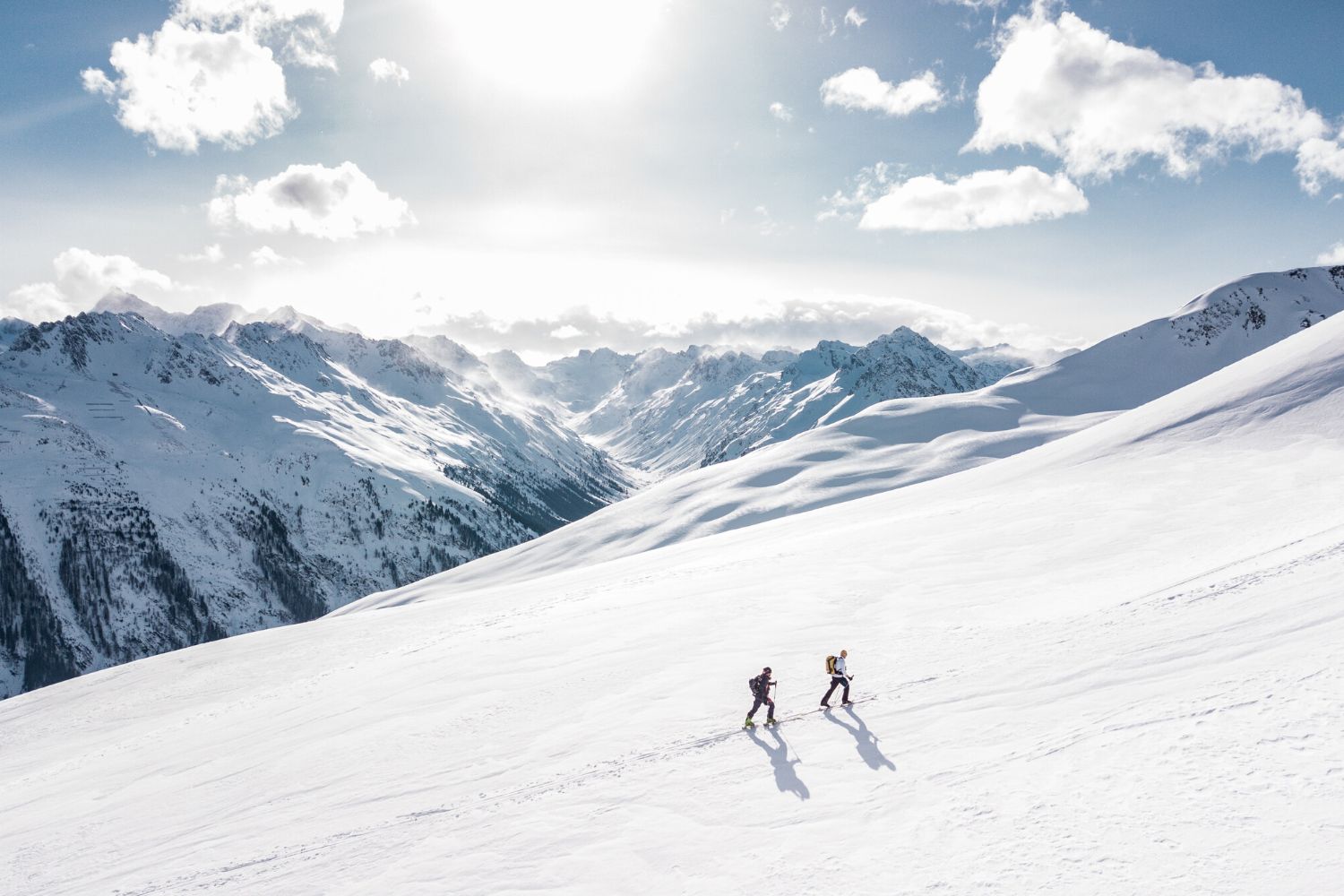Hiking grades and hiking types
We know that it's not always easy to define a hiking grade. To help you find your way, we've worked with our guides to establish physical and technical grades for each activity. By going through them, you'll be able to better assess your abilities. Take the time to consult the day-by-day program, so you can set off with a clear understanding of what you're doing. If in doubt, we'll be delighted to answer any request to help you make the right choice.
1. Hiking Grade
The physical grade indicates an average rating for the entire holiday, along with a precise description of each step, including ascents and descents and time needed to walk.
Grade 1—Beginner:
4 to 5 hours of walking per day maximum. Ascent : 100 to 400 meters.
No specific training required.
Grade 2—Easy:
Approx. 4 to 6 hours of walking per day. Ascent : 400 to 600 meters.
Good physical condition required.
Grade 3—Advanced:
Approx. 5 to 6 hours of walking per day. Ascent : 600 to 1000 meters.
Good physical condition required. Plan to exercise before you leave.
Grade 4—Challenging:
Approx. 6+ hours of walking per day. Ascent : 900 to 1200 meters.
Regular practice of an endurance sport 2 to 3 times a month before departure.
Grade 5—Trekking:
Trekking lasts approximately 7 hours each day. Ascent : More than 1000 meters.
High motivation. For experienced athletes who train several times a week.
Technical difficulty refers to the difficulty of the hike based on the existence and difficulty of several obstacles.
Grade 1—Beginner:
Itinerary or section of an itinerary with hardly any particular obstacle or difficulty of navigation (e.g., urban route).
You can place your foot on a flat surface anywhere.
Grade 2—Easy:
Itinerary or section of an itinerary with ankle-high or smaller obstacles.
You can place your foot on flat or more comfortable surfaces that are easy to spot.
Grade 3—Advanced:
Itinerary or section of an itinerary with at least one obstacle knee-high or below.
Your foot placement adapts to the irregularity of the ground. Foot placement focuses on areas with the best grip.
Grade 4—Challenging:
Itinerary or part of an itinerary with at least one obstacle less than or equal to hip height. Foot placement (toe or heel) adapts to the overall unevenness of the ground.
Using walking sticks is necessary for a comfortable foot balance.
Grade 5—Trekking:
Itinerary or section of an itinerary with at least one obstacle bigger than hip height. Obstacles require the use of the hands. The sections may be or are secured by safety equipment.
Walking sticks can be a nuisance.
Self-assessment questions to ask yourself
To find out whether or not you're fit for a hiking holiday, you'll need to evaluate your physical shape. Do I exercise regularly? What kind of activity do I do? Have I ever hiked or lived at high altitude? Because altitude can play a role in your breathing and therefore in your ability to manage effort. If you've never hiked at high altitude, you'll need to take this into account.
2. Mountain biking
Physical level
Grade 1—Beginner:
Short distances (2 to 3 hours) with few ascents and descents, suitable for beginners or family outings. No previous training required.
Grade 2—Easy:
3 to 4 hours per day, with an ascent of around 550 meters. Ideal for people in good physical shape who take part in an occasional physical activity.
Grade 3—Moderate:
Excursions of 4 to 5 hours, with longer uphill sections (700 to 900 meters ascent). Suitable for regular cyclists with good stamina.
Grade 4—Advanced:
Challenging bike rides of 5 to 6 hours, including days with over 1,000 meters of ascent. A regular mountain biking experience is essential.
Grade 5—Expert:
Very challenging itineraries, with over 1,500 meters of ascent per day, only for experienced cyclists in excellent physical condition.
Technical level
Grade 1—Beginner:
Wide, obstacle-free trails, perfect for a first initiation to mountain biking.
Grade 2—Easy:
Forest trails and a few easy singles, with moderate technical sections where the less experienced can dismount.
Grade 3—Moderate:
Narrower trails with roots, rocks, and bends, requiring control of braking and balance.
Grade 4—Advanced:
Technical descents, jumping over obstacles, and difficult sections. Good riding technique is required.
Grade 5—Expert:
Technical circuits with steep sections, tight switchbacks, and natural obstacles, requiring perfect control of the bike.
How can electric assistance help at every level?
Electric assistance makes certain levels accessible to a greater number of riders, particularly in terms of physical fitness.
Beginner to Easy (grades 1 and 2): The VTTAE allows you to enjoy a ride without too much effort, perfect for beginners or families.
Moderate (Level 3): Assistance makes it easier to handle long, steep uphill climbs while still requiring good technical control.
Advanced (Level 4): The VTTAE helps to combine long distances but does not replace the need for a solid riding technique on more technical sections.
Expert (Level 5): Electric assistance is not necessarily an advantage on highly technical circuits, where cycling skills remain paramount.
Using a VTTAE allows you to better manage your effort but does not replace the technical skills needed on rough trails.
Hiking types
Single-centered hiking : All week, based in the same hotel or gîte. You leave in the morning on foot or with a transfer and return in the evening. The advantage of this type of package is that you don't have to pack every day, and you can take a break during the week.
Point-to-point hiking : Point-to-point hikes are circuits during which you change accommodation each day. You leave and arrive on foot.
Multi-center hiking : Multi-center hikes have several separate accommodations (usually 2 or 3) from which you set off on foot or with a transfer.
Self-guided car tours : Self-guided car tours are free tours for which a vehicle is required. We offer car rental, or you can use your own vehicle. This type of tour allows you to discover several destinations in one trip, in complete autonomy.
3. Snowshoeing
Physical Level
The physical requirements for snowshoeing are roughly the same as for hiking, but with the extra difficulty of moving through snow.
Grade 1—Beginner:
4 to 5 hours of walking per day
Ascent: 300 to 500 meters
No specific training required.
Grade 2—Easy:
4 to 6 hours of walking per day
Ascent: between 400 and 600 meters
Good physical condition required.
Grade 3—Advanced:
5 to 6 hours of walking per day
Ascent: between 600 and 1,000 meters
Good physical condition required.
Training recommended.
Grade 4—Challenging:
6 hours or more of walking per day
Ascent: between 900 and 1,200 meters
Very good physical condition required.
Practicing an endurance sport 2 to 3 times a month prior to departure
Grade 5—Trekking:
Trekking for 7 hours per day
Ascent: Over 1,000 meters
Highly motivated and for experienced athletes
Training several times a week on a regular basis.
Technical level
Grade 1—Beginner:
Snowshoeing on smooth ground with gentle slopes. No technical sections. Suitable for beginners.
Grade 2—Easy:
Itinerary with some moderate ascents and valleys. We recommend a first snowshoeing experience, even a short one.
Grade 3—Moderate:
A varied itinerary combining moderate ascents and occasional steep descents. Good physical condition and ability to handle snowy surfaces required.
Grade 4—Advanced:
Snowshoeing on steep slopes, which may include technical sections in deep snow or ice. Overcoming obstacles. Comfortable in all types of snow and able to manage the necessary progression techniques.
Grade 5—Expert:
Snowshoeing on slopes that can be steep, with some technical sections. Comfort on all types of snow and adaptability are essential.
4. Nordic ski touring
Physical Level
Grade 1—Beginner:
At this level, you'll be able to hike an ascent of 200 to 300 meters, which represents around 2 to 3 hours of activity. We recommend practicing once or twice a month to prepare for this level.
Grade 2—Easy:
This level involves an ascent of between 300 and 600 meters, with tours lasting 3 to 4 hours. It is advisable to practice this level regularly, about two or three times a month.
Grade 3—Moderate:
This level involves a vertical drop of 600 to 900 meters and skiing sessions of 4 to 5 hours. The ideal practice rhythm for this level is 1 to 2 times a week.
Grade 4—Advanced:
Challenging ski tours lasting 5 to 6 hours, with days exceeding 1,000 meters of vertical drop. Regular ski mountaineering experience is essential.
Grade 5—Expert:
This level requires very good physical condition, with an ascent over 1,200 meters and sessions lasting more than 6 hours. You'll need to be able to practice regularly, often more than three times a week.
Technical level
Grade 1—Discovery:
The itinerary is easy, mainly on clear, marked trails with no particular difficulties. Altitudes are generally below 1,500 meters, and there are no major obstacles on the way, with fairly flat or slightly undulating terrain.
Grade 2—Easy:
This level covers only minor obstacles but includes some slight slopes and stretches of unplowed snow. Generally, altitudes do not exceed 2,000 m, and the obstacles remain simple: a few short ascents, descents, and stretches of deep snow. The terrain is not particularly exposed, but may sometimes require a little more skiing skill. A first experience of Nordic skiing is recommended.
Grade 3—Moderate:
This level is more diverse, with steeper slopes and the occasional powder snow. Altitudes can reach up to 2,500 m, and there may be obstacles in the form of lightly tracked snow sections. Some stretches may require technical maneuvers, especially to overcome natural obstacles or navigate in less predictable snow conditions.
Grade 4—Confirmed:
The itinerary gets much more challenging, with wild, little-tracked terrain, where technical skills of ascent and descent in snowy terrain become essential. Altitudes can reach up to 3,000 m. Due to the remoteness of some itineraries, obstacles such as steep slopes and variable snow patches will be involved, requiring an advanced level of technical skills.
Grade 5—Expert:
Sometimes difficult, often unmarked itineraries on steep slopes in high-altitude areas. Altitudes frequently exceed 3000 m, and obstacles are numerous and complex, such as extremely steep slopes, highly variable snow (crusty, deep, or icy), and difficult terrain, requiring advanced skills for steep descents and maneuvers in mountainous or exposed environments.
5. Alpine ski touring
Physical level
Grade 1—Beginner:
This level is suitable for those with a reasonable level of fitness, involving an ascent between 200 and 400 meters for excursions of 2 to 3 hours. This level is recommended for occasional practice, about once or twice a month.
Grade 2—Easy:
Physically, this level involves an ascent between 400 and 700 m, with excursions lasting 3 to 4 hours. Regular practice is recommended, around two or three times a month.
Grade 3—Moderate:
This level involves an ascent of 700 to 1000 m, with excursions lasting 4 to 5 hours. This level should be practiced regularly, about once or twice a week.
Grade 4—Confirmed:
Physically, this itinerary requires a higher level of fitness, with an ascent of 1,000 to 1,400 meters for excursions of 5 to 6 hours. This level should be practiced frequently, two or three times a week.
Grade 5—Expert:
This level requires a high level of fitness and experience, with a vertical drop of over 1400 m and excursions lasting over 6 hours. A high level of fitness is required, with several trips per week.

Technical level
Grade 1—Beginner:
This level's itinerary is easy, with gentle slopes and regular ascents. Altitudes generally do not exceed 1,500 m, and the terrain is mainly well-marked and well-traced. There are no major obstacles to overcome, allowing skiers to get to grips with the basics of ascending and descending ski mountaineering.
Grade 2—Easy:
Technically, the itinerary can include moderate slopes and less marked terrain. Altitudes may reach 2,000 m, and simple obstacles such as sections of unplowed snow or steeper slopes may be encountered. Managing conversions and descent techniques in snow powder or on slightly steeper slopes is required at this level.
Grade 3—Moderate:
This itinerary is more complex, with steep slopes and less well-marked trails. Altitudes can reach 2,500 m. Skiers will have to deal with variable snow conditions, including deep snow and icy conditions. Technical maneuvers are required to overcome natural obstacles such as boulders, and descents may involve steep slopes or narrow passageways where agility and the ability to handle conversion and descent techniques are essential.
Grade 4—Confirmed:
Technically, the itinerary is challenging, with steep slopes, unmarked trails, and point-to-point itineraries in mountainous terrain. Altitudes can reach 3,000 m and beyond. The obstacles include steep, exposed slopes; various types of snow (crusty, deep, icy); and passageways where technical skills are required to manage difficult descents and potential falls. The ability to use safety equipment such as avalanche transceivers, shovels, and probes is also crucial.
Grade 5—Expert:
The itineraries are challenging, with very steep slopes and very varied and often unmarked terrain. Altitudes can exceed 3,000 m, and the natural obstacles are numerous and complex: steep slopes, highly variable snow (powder, crusty, icy), and exposed terrain. Skiers and snowboarders need to be able to navigate in extreme conditions, manage technical descents, and convert on steep slopes with great ease. Advanced mountain safety techniques (avalanche, search and rescue) are essential.
6. Cross-country skiing
Physical level
Grade 1—Discovery
This level is suitable for anyone with a reasonable level of physical fitness. The routes are relatively short, between 5 and 10 km, with a slight ascent of less than 100 m and a time of effort of about 1 to 2 hours. Occasional practice, once or twice a month, is enough to progress.
Grade 2—Easy
Physically, this level involves distances between 10 and 20 km, with a reasonable ascent of 100-300 m and a time span of 2 to 3 hours.
Grade 3—Moderate:
This level requires good stamina, with distances of around 20 km, an ascent of 300 to 600 m, and a 3-4 hour circuit. It is recommended to exercise at least once a week to maintain good physical condition.
Grade 4—Confirmed:
This level requires a good level of fitness, with distances ranging from 20 to 50 km, an ascent of 600 to 1000 m, and trips lasting from 4 to 6 hours. Regular practice, at least twice a week, is necessary to maintain this level of endurance.
Grade 5—Expert:
Highly challenging itineraries, with more than 1,500 m of ascent per day, are reserved for experienced skiing people in excellent physical condition.
Technical level
Grade 1—Discovery:
The itinerary is easy and fully groomed, with wide, well-maintained trails. The trail is not particularly undulating, with gentle ascents and descents. This level allows you to learn the basics of alternating steps in classic and the first supports in skating without requiring great balance skills.
Grade 2—Easy:
The itinerary features some steeper ascents and longer descents, requiring better balance control. The snow can be varied, depending on weather conditions. In classical skiing, it's important to master pushing and gliding. In skating, the basics of the skating step must be acquired to manage effort and movement coordination.
Grade 3—Moderate:
This itinerary is more challenging, with long and sometimes steep ascents, as well as more technical descents requiring good speed and trajectory control. The snow can be unpredictable, with both hard and soft sections. In classic skiing, you need to know how to manage alternating between gliding and climbing. In skating, the transition between the different steps (2-stroke, 1-stroke, combined) must be fluid, depending on the terrain.
Grade 4—Confirmed:
The itineraries are challenging, with steep ascents and swift descents requiring excellent control of support and balance. The snow can be changeable, requiring a good adaptability to sliding conditions. In classical skiing, propulsion must be efficient, with good use of arms and legs. In skating, you need to be able to vary your techniques according to the slope of the terrain and muscle fatigue.
Grade 5—Expert:
The itineraries are challenging, with long, steep climbs and technical descents requiring perfect control of speed and trajectories. The snow can vary, and some sections may be poorly packed or frozen. Classical skiing requires excellent coordination to maximize glide and conserve energy. In skating, the transition between steps must be instinctive, and effort management must be optimized to last over time.










